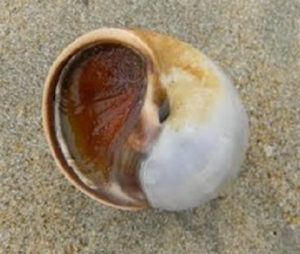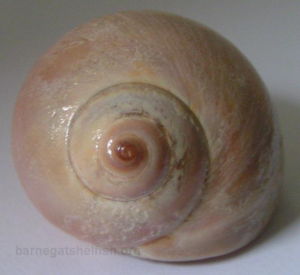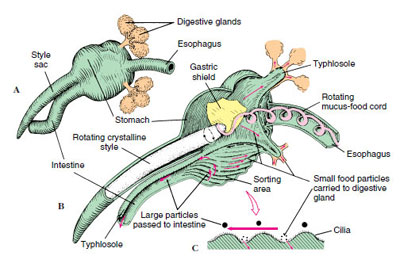
Snails Family gastropodia
Snail Menu
Snails
Snail Anatomy
Mud Dog Whelk (Mud Snail)
Moon Snails
Radula
Slipper Shell
Oyster Drill
Murex Snails

Marine Snails Gastropoda Latin: gaster=stomach podus=foot
Moon Snails
 Moon snails are found in all seas around the world and throughout Barnegat Bay. They are carnivorous predators who’s major food source is calms and other shellfish (even other moon snails).
Moon snails are found in all seas around the world and throughout Barnegat Bay. They are carnivorous predators who’s major food source is calms and other shellfish (even other moon snails).
Moon snails have a large grey to tan shell (adults about 3 to 5 inches)
The foot and mantle have hollow sinuses into which water can be pumped to expand them greatly out and over the shell (illustrated in the image to the left)
The snail pumps water into its mantle and foot to increase its mass by 3 to 4 times the size of its shell
They use this foot to travel along or burrow into the sandy or muddy bay bottom in search of prey.

When threatened, they pump out the water to retract their entire body into the shell and seal the entrance with the operculum
Atlantic Moon Snail Polinices duplicatus
 The Atlantic moon snail or “Shark’s Eye” has a bluish gray-brown color with a distinctive dark “eye” at the tip of the spire as shown in the image to the left
The Atlantic moon snail or “Shark’s Eye” has a bluish gray-brown color with a distinctive dark “eye” at the tip of the spire as shown in the image to the left
They grow to about 3 inches in diameter.
The Atlantic moon snail, like most other moon snails has its umbilicus filled in or partially filled in as the shell grows.
Northern Moon Snail Euspira heros
 Northern moon snails grow up to 4 – 5 inches high and almost equally as wide (almost round). The shell is smooth and grayish-white to brownish-gray in color.
Northern moon snails grow up to 4 – 5 inches high and almost equally as wide (almost round). The shell is smooth and grayish-white to brownish-gray in color.
One feature that is unique to the northern moon snail is umbilicus.
As a snail grow, its shells revolve around a central axis, or columella.
In young snails this growth results in a hollow tube running through the center of the shell called an umbilicus. Normally this “navel” is filled in with calcium as the animal grows. In the northern moon snail this umbilicus is not filled in
Snails are univalves, meaning they have one shell (valve) to which they can retract their whole body into when threatened.
They can be algae eaters (algivorous), feed on other animals (carnivorous) or feed on both plants and animals (omnivorous) as predators and scavengers.
Projecting out in front of the snail are two tentacle which are used for sight. Another set are used for touch. Below these tentacle is the mouth.
Snails are univalves, meaning they have one shell (valve) to which they can retract their whole body into when threatened.
They can be algae eaters (algivorous), feed on other animals (carnivorous) or feed on both plants and animals (omnivorous) as predators and scavengers.
Projecting out in front of the snail are two tentacle which are used for sight. Another set are used for touch. Below these tentacle is the mouth.
Fun Fact – Moon snails are nocturnal. They do most of their hunting at night and spend the day buried in the sand or mud of the bay bottom
